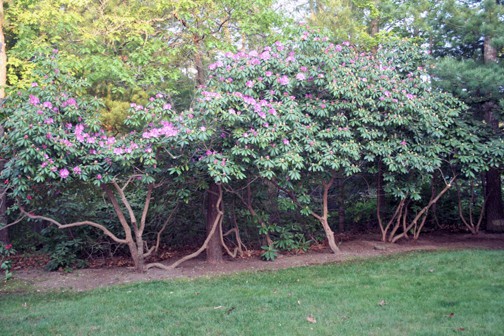When speaking to a live audience, or hosting GardenLine on WXTK, I frequently get into conversations that go like this:
 Caller: “I’m wondering if I can prune my rhododendrons now…they’ve gotten out of control.”
Caller: “I’m wondering if I can prune my rhododendrons now…they’ve gotten out of control.”
Me: “Do you mean they’ve grown too big?”
Caller: “Yes! They’re in front of the house and are covering the windows, so I need to cut them back.”
Most of the time I tell these listeners just what they don’t want to hear: don’t cut them down, move them somewhere else.
I advise that the plants be transplanted because pruning them simply delays the inevitable. If you cut these shrubs significantly they’ll look hacked for a couple of years, and just about the time when they start to recover they’re once again too large.
Yes, it’s possible to slow a plant’s growth with annual pruning, and some people effectively keep their Rhodys under the windows with this approach. To be successful with this approach, however, you need to start before the plants get too large. You also need to be willing to cut down a third of the taller stems and occasionally remove some of the new growth, doing both immediately after the plant flowers. Most people don’t have the patience for this and end up not dealing with the size of their plants until they are too big.
Although large Rhododendrons in foundation plantings are usually best dealt with through relocation, in some instances arborizing large rhododendrons is a good solution. This is especially appropriate for shrubs that have been planted near the corners of the house, or for places where the top of the Rhododendrons already extends up over the windows. Many rhodys can be turned into very attractive, multi-stemmed, small trees.

The beauty of limbing up a rhody is that once you begin thinking of them as multi-stemmed, small trees, you can just let them grow tall. You can stop worrying about when to prune them so that you won’t do damage to future flowers. In fact, other than removing deadwood and perhaps some of the lower branches, you don’t have to do any pruning at all.
To decide if this approach is good for your shrubs, view the plants from several sides, parting the foliage so you can view the trunks and imagine how they would look if exposed. Think in terms of sculptural, natural shapes, not straight-up tree trunks.
To arborize a plant, you’ll remove the side stems, working from the ground up. Start with the removal of the lowest side branches, following them back to where they join the trunks and cutting them off there. Don’t make the cut flush with the trunk, but instead leave a stub just under an inch long.
If possible, doing this in two-year stages is a good idea. The first year remove the bottom one quarter of the plant’s total side branches, again, working from the bottom up. The second year take off the next quarter so that you’ve removed one half of the plant’s total canopy and clearly see the trunks. Make these cuts in the spring or early summer so that the new growth that such pruning will stimulate will has the entire season to develop.
The third year, start refining the appearance by taking a few more side branches off, or even removing a main stem that looks awkward. Don’t yield to the temptation to become a Marine Corps barber; take it slowly, and make a few cuts at a time, pausing to live with the results for a while before continuing.
After exposing the trunks you can begin tucking some low, shade-loving perennials around the Rhododendrons. Japanese painted ferns, Tiarella, and the shorter Hosta are just some of the choices for attractive understory plants.
So if your Rhododendrons are too large, instead of thinking you have to chop them down, consider limbing them up!
